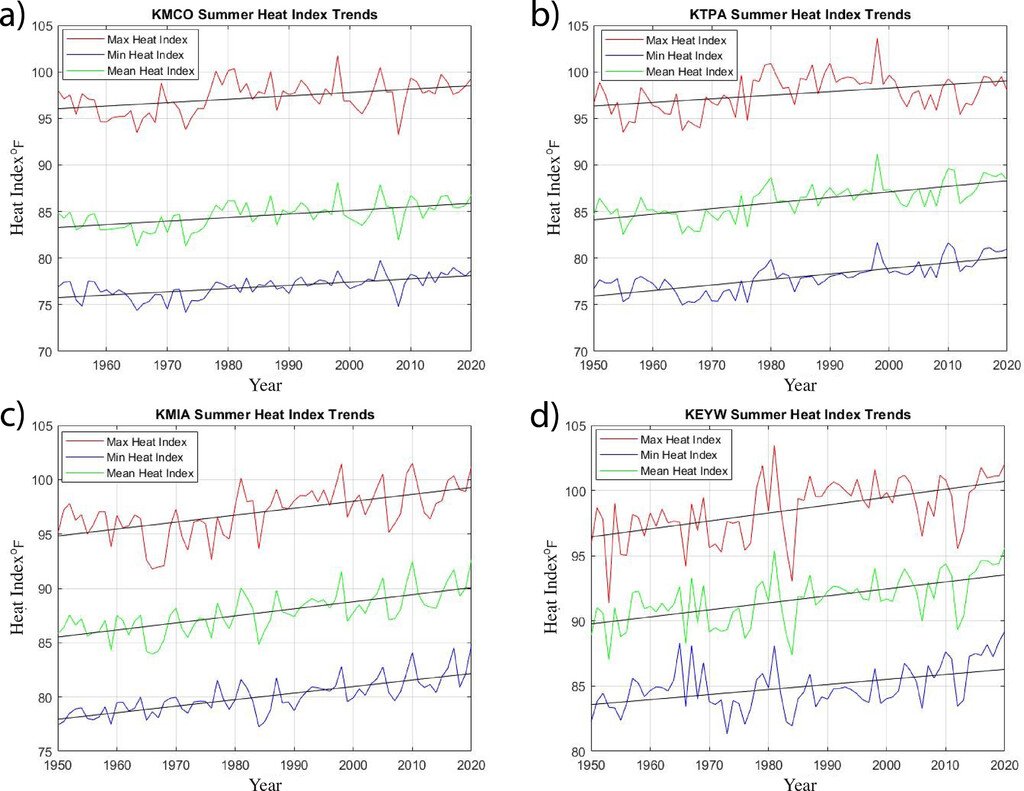Humid Heat Stress Observations and Trends
Extreme heat is the deadliest U.S. weather hazard. Humid heat stress, defined by Di Napoli et al. (2019) as “high temperatures and moisture levels . . . that can undermine the human body’s ability to maintain its core temperature within the range of optimal physiological performance,” represents the combined impacts of extreme heat and humidity that can be difficult for the human body to tolerate. Although there are many metrics (e.g., heat index) that measure humid heat stress, many do not account for solar radiation and wind, which can have large impacts on human tolerance and health. Our heat stress work primarily takes a wet bulb globe temperature (WBGT) approach to identifying observations and trends in heat stress, because WBGT incorporates solar radiation and wind speed.
Ongoing NOAA-funded work by our research group investigates WBGT estimation formulas and trends across the Southeast U.S. Our goal is to establish a regional extreme heat stress monitor/rating system that incorporates social vulnerabilities by 2025.
Although Florida is known for its warm and humid climate, it is not immune from heat stress impacts on human health, particularly given its older population and prevalence of outdoor (e.g., agriculture, construction) work. Recently we published a study in the International Journal of Climatology showing humid heat stress is no longer just a summer problem in Florida. Trends in Autumn WBGT are significantly positive across the state, especially at coastal locations in the Florida Peninsula and at night. These trends are potentially linked to significant increases in Atlantic Ocean and Gulf of Mexico heat content, particularly in September.
See key study results in the figures below
Our 2022 published study in the Journal of Applied Meteorology and Climatology analyzed summer trends in WBGT and heat index at eight Florida cities since 1950. Results (see below) showed that heat stress is increasing significantly, particularly at coastal locations in central and southern Florida and at night. The number of extreme/dangerous heat stress days and nights per summer has also increased across Florida, especially since 2000. Our analysis emphasizes that despite some acclimation, Florida is still susceptible to a serious escalation in extreme heat as the climate warms.
Florida Heat Waves
Heat waves are increasing in frequency, duration, and intensity in a warming world, and are generally the most strongly linked extreme weather event to anthropogenic climate change. Florida’s older-skewed population and increasingly urbanized land areas make it particularly susceptible to heat impacts on human life and health. Our research examines trends in frequency, intensity, and duration of heat waves and related heat stress across Florida.
Our 2019 observational study showed that the frequency and duration of Florida heat waves have increased over the past seven decades, particularly at night when impacts to human health tend to be larger. Our follow-up modeling study found that if climate warming continues unabated throughout the next few decades, heat waves in Florida will become more frequent and longer, and may affect extreme precipitation events. Check out the ERAU press release and Daytona News-Journal article describing results from both studies!
The plots below from our 2019 observational study show:
Trends in heat wave frequency at six major Florida airports since 1950. Note the pronounced increases at Tallahassee, Tampa, and Key West, especially for minimum and mean temperature heat waves.
Heat wave duration trends at the same airports since 1950. Results show that mean and minimum temperature heat waves have dramatically increased in length at most airports across the state.











